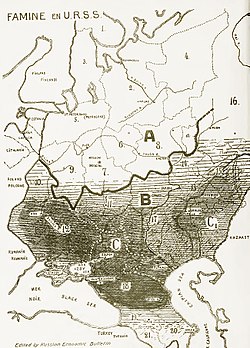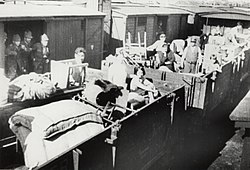Census data
Writing in Slavic Review , demographers Barbara Anderson and Brian Silver maintained that limited census data make a precise death count impossible. Instead, they offer a probable range of 3.2 to 5.5 million excess deaths for the entire Soviet Union from 1926 to 1939, a period that covers collectivization, the civil war in the countryside, the purges of the late 1930s and major epidemics of typhus and malaria. [62] In 2001, American historian Richard Pipes argued that the population had decreased by 9 to 10 million people from the 1932 to 1939 censuses. [63] The 17th Congress of the UCP estimated that the USSRs population was 168 million in 1933, and predicted that it would grow to 180 million by 1937, yet the 1937 census registered only 162 million people, a decrease in population. The mortality rate was double the average one than in Europe at that time. [64]
Modern estimates
Some historians claim that the death toll was around 20 million, [72] a figure based on Conquest's book The Great Terror (1968), with some estimates relying in part on demographic losses such as Conquest's. [73] In 2003, British historian Simon Sebag Montefiore suggested that Stalin was ultimately responsible for the deaths of at least 20 million people. [74] In 2006, political scientist Rudolph Rummel wrote that the earlier higher victim total estimates are correct, although he included those killed by the government of the Soviet Union in other Eastern European countries as well. [75] [76] In his most recent edition of The Great Terror (2007), Conquest stated that while exact numbers may never be known with complete certainty, at least 15 million people were killed "by the whole range of Soviet regime's terrors." [77] According to Barbara Anderson and Brian Silver, historians such as Robert Conquest made the most primitive of errors. They asserted that these Cold Warriors overestimated fertility rates and underrated the impact of assimilation, through which many Ukrainians were redesignated as Russians in the 1939 census, confusing population deficits, which included unborn children, with excess deaths. [62]
Historians such as J. Arch Getty, Stephen G. Wheatcroft, and others, insist that the opening of the Soviet archives has vindicated the lower estimates put forth by the revisionist school. [78] [79] In 2011, after assessing twenty years of historical research in Eastern European archives, American historian Timothy D. Snyder stated that Stalin deliberately killed about 6 million, which rise to 9 million if foreseeable deaths arising from policies are taken into account. [80] [81] American historian William D. Rubinstein concluded that, even under most conservative estimates, Stalin was responsible for the deaths of at least 7 million people, or about 4.2% of USSRs total population—meaning 1 in 24 Soviet citizens. [82]
Some historians believe that the official archival figures of the categories that were recorded by Soviet authorities are unreliable and incomplete. [1] In addition to failures regarding comprehensive recordings, as one additional example, Canadian historian Robert Gellately and Montefiore argue that the many suspects beaten and tortured to death while in "investigative custody" were likely not to have been counted amongst the executed. [84] Conversely, Wheatcroft states that prior to the opening of the archives for historical research, "our understanding of the scale and the nature of Soviet repression has been extremely poor" and that some specialists who wish to maintain earlier high estimates of the Stalinist death toll are "finding it difficult to adapt to the new circumstances when the archives are open and when there are plenty of irrefutable data" and instead "hang on to their old Sovietological methods with round-about calculations based on odd statements from emigres and other informants who are supposed to have superior knowledge." [85] [3] British historian Michael Ellman argues that mass deaths from famines should be placed in a different category than the repression victims, mentioning that throughout Russian history famines and droughts have been a common occurrence, including the Russian famine of 1921–1922, triggered by Stalin's predecessor Vladimir Lenin's war communism policies, which killed about five million people. [86] [87] He also states that famines were widespread throughout the world in the 19th and 20th centuries in countries such as China, India, Ireland, and Russia. [20] Ellman compared the behaviour of the Stalinist regime vis-à-vis the Holodomor to that of the British government (towards Ireland and India) and the G8 in contemporary times. According to Ellman, the G8 "are guilty of mass manslaughter or mass deaths from criminal negligence because of their not taking obvious measures to reduce mass deaths" and Stalin's "behaviour was no worse than that of many rulers in the nineteenth and twentieth centuries." [20] Ben Kiernan, an American academic and historian, described Stalin's era as "by far the bloodiest of Soviet or even Russian history". [88]
Numbers of deaths caused by Stalinism, 1924–1953 (excluding killings outside of Soviet borders)| Event | Est. number of deaths | References |
|---|
| Dekulakization | 530,000–600,000 | [89] |
| Great Purge | 700,000–1,200,000 | [49] [14] |
| Gulag | 1,500,000–1,713,000 | [20] [13] |
| Soviet deportations | 450,000–566,000 | [90] [91] |
| Katyn massacre | 22,000 | [92] |
| Holodomor | 2,500,000–4,000,000 | [93] |
| Kazakh famine of 1931–33 | 1,450,000 | [94] |











